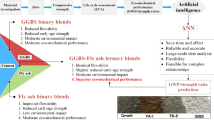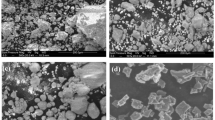Abstract
Producing cements incorporating high-volume replacement of ordinary portland cement (OPC) by recycled industrial by-products is perceived as the most promising venture for the cement and concrete industry to meet its environmental obligations. However, the two-component (binary) cements thus produced are often associated with shortcomings such as the need for extended moist-curing, increased use of chemical admixtures, low early age strength, increased cracking tendency due to drying shrinkage, and de-icing salt scaling problems. There is need for research to investigate whether high-volume replacement multi-component (ternary and quaternary) cements could be optimized with synergistic effects allowing component ingredients to compensate for any mutual shortcomings. This study uses factorial experimental plans to investigate the performance of OPC-silica fume (SF)-class F fly ash (FA) and OPC-SF-ground granulated blast furnace slag (GBFS) ternary cementitious blends. Response surfaces for the superplasticizer requirement to achieve a constant flow, setting time, drying shrinkage up to 112 days, compressive strength at 1, 7, 28 and 56 days, and for the sulfate expansion up to 9-months were obtained for up to 20%, 60%, and 60% replacement levels of OPC by SF, FA and GBFS, respectively. A multiparametric optimization is used to establish response surfaces for a desirability function, which is used to rate ternary cementitious blends. Results indicate that when rheological, mechanical, durability and cost requirements are combined; the use of costly mineral admixtures such as silica fume is not economic in ternary OPC-SF-FA or OPC-SF-GBFS blends beyond levels of about 3 to 5% Moreover, it is shown that the major hurdle for high-volume replacement of OPC with class F fly ash is compromising the early age performance. Results also indicate that a good quality high-fineness GBFS can be used at replacement levels of OPC up to 60% without major disadvantages.
Résumé
La production de ciments incluant de hautes proportions de déchets industriels est considérée comme l'entreprise la plus prometteuse afin que l'industrie du ciment et du béton remplisse ses devoirs environnementaux. Cependant, les ciments binaires (2 composants) ainsi produits sont souvent associés à des inconvénients tels que le besoin de mûrissement humide plus prolongé et un dosage d'adjuvants chimiques plus élevé, une faible résistance en compression au jeune âge, vulnérabilité accrue à la fissuration par retrait de séchage et une plus faible résistance à l'écaillage par les sels de déglaçage. Il est nécessaire de savoir si des ciments à plusieurs composants (ternaires et quaternaires) ont des effets synergiques de façon à ce que leurs ingrédients compensent pour leurs faiblesses mutuelles. Cette étude utilise des plans factoriels pour examiner la performance de ciments ternaires incluant du ciment Portland, de la fumée de silice, des cendres volantes de classe F ou du laitier de haut fourneau. Des courbes d'iso-réponses pour le dosage de superplastifiant requis pour donner un écoulement constant, le temps de prise, le retrait de séchage jusqu'à 112 jours, la résistance en compression à 1, 7, 28 et 56 jours, et pour l'expansion due aux sulfates jusqu'à 9 mois ont été obtenues pour des niveaux de remplacement du ciment Portland de 20%, 60% et 60% avec, respectivement, de la fumée de silice, des cendres volantes et du laitier de haut fourneau. Une optimisation multi-paramétrique a été utilisée pour établir une “fonction de désirabilité” permettant de clasifier des ciments ternaires par ordre de préférence. Les résultats indiquent que lorsque les exigences rhéologiques, mécaniques, de durabilité ainsi qu'économiques sont prises en compte, l'utilisation d'ajouts minéraux à coût élevé comme la fumée de silice dans les ciments ternaires examinés n'est pas justifiée au-delà d'environ 3 à 5%. De plus, il semble que l'obstacle majeur pour l'utilisation des ciments à haut dosage en cendres volantes de classe F est leur faible performance au jeune âge. Les laitiers de haut fourneau de bonne qualité et à haute finesse par contre, peuvent être utilisés à des dosages aussi hauts que 60% sans inconvénients majeurs.
Similar content being viewed by others
References
Clough, G. W., ‘Civil engineering in the next millennium’, Presented at the MIT CEE New Millennium Colloquium (March 2000) 13 p.
Mehta, P. K., ‘Concrete technology for sustainable development’,Concrete International 21 (11) (1999) 47–53.
Nehdi, M., ‘ernary and quaternary cements for sustainable development’,Concrete International 24 (4) (2001) 35–42.
Nehdi, M., Mindess, S. and Aïtcin, P.-C., ‘Statistical modeling of the microfiller effect on the rheology of composite cement pastes’,Advances in Cment Research 9 (33) (1997) 37–46.
Douglas, E. and Pouskouleli, G., ‘Prediction of compressive strengths of mortars made with portland cement-blast furnace slag-fly ash blends’,Cement and Concrete Research 21 (4) (1991) 523–534.
Wang, D. and Chen, Z., ‘On predicting compressive strengths of mortars with ternary blends of cement, GGBFS and fly ash’,Cement and Concrete Research 27 (4) (1997) 487–493.
Design Expert, Version 5.0.3, STAT-EASE-Inc., 2021 East Hennepin Ave., Suite 191, Minneapolis, MN 55413.
Nagataki, S. and Wu, C., ‘A study of portland cement incorportating silica fume and blast furnace slag’, in CANMET-ACI SP-153. Malhotra, V. M., editor, II (1995) 1051–1068.
Swamy, R. N., ‘Design for durability and strength through the use of fly ash and slag in concrete’, in 3rd CANMET-ACI International Conference on Advances in Concrete Technology, SP-171, Malhotra, V.M., editor. (1997) 1–72.
Thomas, M. D. A., Shehata, M. H., Shashiprakash, S. G., Hopkins, D. S. and Cail, K., ‘Use of ternary cementitious systems containing silica fume and fly ash in concrete’,Cement, and Concrete Research 29 (1999) 1207–1214.
Dunstan, E. R., ‘Possible methods of identifying fly ashes that will improve sulphate resistance’,Cement, Concrete and Aggregates 2 (1) (1980) 20–30.
Tikalsky, P. J. and Carrasquillo, R. L., ‘Influence of fly ash on the sulphate resistance of concrete’,ACI Materials Journal 89 (1) (1992) 69–75.
ACI Committee 232, ‘Use of fly Ash in Concrete’, (American Concrete Institute, Farmington Hills, Michigan, 1996).
Author information
Authors and Affiliations
Rights and permissions
About this article
Cite this article
Nehdi, M.L., Summer, J. Optimization of ternary cementitious mortar blends using factorial experimental plans. Mat. Struct. 35, 495–503 (2002). https://doi.org/10.1007/BF02483137
Received:
Accepted:
Issue Date:
DOI: https://doi.org/10.1007/BF02483137




